Launched: July 20, 2020
Landed: Thursday, Feb. 18, 2021
Location on Mars: Jezero Crater
The Mars 2020 mission takes the next step by not only seeking signs of habitable conditions on Mars in the ancient past, but also searching for signs of past microbial life itself. The Perseverance rover introduces a drill that can collect core samples of the most promising rocks and soils and set them aside in a "cache" on the surface of Mars. A future mission could potentially return these samples to Earth. That would help scientists study the samples in laboratories with special room-sized equipment that would be too large to take to Mars. The mission also provides opportunities to gather knowledge and demonstrate technologies that address the challenges of future human expeditions to Mars. These include testing a method for producing oxygen from the Martian atmosphere, identifying other resources (such as subsurface water), improving landing techniques, and characterizing weather, dust, and other potential environmental conditions that could affect future astronauts living and working on Mars.
The Perseverance landing system included a parachute, descent vehicle, and an approach called a "skycrane maneuver" for lowering the rover on a tether to the surface during the final seconds prior to landing. This type of landing system provides the ability to land a very large, heavy rover on the surface of Mars in a more precise landing area than was possible before Curiosity's landing. The Perseverance rover adds new entry, descent, and landing (EDL) technologies, such as Terrain-Relative Navigation (TRN). Terrain-Relative Navigation allows the rover to detect and to avoid hazardous terrain by diverting around it during its descent through the Martian atmosphere. A microphone allows engineers to analyze entry, descent, and landing. It might also capture sounds of the rover at work, which would provide engineers with clues about the rover's health and operations.
It is car-sized, about 10 feet long (not including the arm), 9 feet wide, and 7 feet tall (about 3 meters long, 2.7 meters wide, and 2.2 meters tall). But at 2,314 pounds (1,050 kilograms), it weighs less than a compact car.
On Mars, the arm and turret will work together, allowing the rover to work as a human geologist would: by reaching out to interesting geologic features, scraping, analyzing and even collecting them for further study via Mars 2020's Sample Caching System, which includes 17 motors and will collect samples of Martian rock and soil that will be returned to Earth by a future mission.
The probe will explore the Jezero crater and an ancient delta, where Perseverance will scour for signs of fossilized microbes on Mars. It was manufactured by the Jet Propulsion Laboratory and launched July 30,2020, at 7:50 a.m. EDT.
The probe entered Mars' atmosphere and deployed parachutes to slow its descent. The booster rockets fired on the descent vehicle. A skycrane separated from the rover. Cables from the skycrane gently lowered the Perseverance to the surface of the planet. It landed on Mars Feb. 18, 2021 sfter a 203-day journey traversing 293 million miles (472 million kilometers). Confirmation of the successful touchdown was announced in mission control at NASA’s Jet Propulsion Laboratory in Southern California at 3:55 p.m. EST (12:55 p.m. PST).
The probe landed in the Jezero Crater, which is 28 miles wide. Scientists believe the area was once flooded with water and was home to an ancient river delta. More than 3.5 billion years ago, river channels spilled over the crater wall and created a lake. Scientists see evidence that water carried clay minerals from the surrounding area into the crater lake. Conceivably, microbial life could have lived in Jezero during one or more of these wet times. If so, signs of their remains might be found in lakebed or shoreline sediments. Scientists will study how the region formed and evolved, seek signs of past life, and collect samples of Mars rock and soil that might preserve these signs.
“This landing is one of those pivotal moments for NASA, the United States, and space exploration globally – when we know we are on the cusp of discovery and sharpening our pencils, so to speak, to rewrite the textbooks,” said acting NASA Administrator Steve Jurczyk. “The Mars 2020 Perseverance mission embodies our nation’s spirit of persevering even in the most challenging of situations, inspiring, and advancing science and exploration. The mission itself personifies the human ideal of persevering toward the future and will help us prepare for human exploration of the Red Planet in the 2030s.”
About the size of a car, the 2,263-pound (1,026-kilogram) robotic geologist and astrobiologist will undergo several weeks of testing before it begins its two-year science investigation of Mars’ Jezero Crater. While the rover will investigate the rock and sediment of Jezero’s ancient lakebed and river delta to characterize the region’s geology and past climate, a fundamental part of its mission is astrobiology, including the search for signs of ancient microbial life. To that end, the Mars Sample Return campaign, being planned by NASA and ESA (European Space Agency), will allow scientists on Earth to study samples collected by Perseverance to search for definitive signs of past life using instruments too large and complex to send to the Red Planet.
“Because of today’s exciting events, the first pristine samples from carefully documented locations on another planet are another step closer to being returned to Earth,” said Thomas Zurbuchen, associate administrator for science at NASA. “Perseverance is the first step in bringing back rock and regolith from Mars. We don’t know what these pristine samples from Mars will tell us. But what they could tell us is monumental – including that life might have once existed beyond Earth.”
Some 28 miles (45 kilometers) wide, Jezero Crater sits on the western edge of Isidis Planitia, a giant impact basin just north of the Martian equator. Scientists have determined that 3.5 billion years ago the crater had its own river delta and was filled with water.
The power system that provides electricity and heat for Perseverance through its exploration of Jezero Crater is a Multi-Mission Radioisotope Thermoelectric Generator, or MMRTG. The U.S. Department of Energy (DOE) provided it to NASA through an ongoing partnership to develop power systems for civil space applications.
Equipped with seven primary science instruments, the most cameras ever sent to Mars, and its exquisitely complex sample caching system – the first of its kind sent into space – Perseverance will scour the Jezero region for fossilized remains of ancient microscopic Martian life, taking samples along the way.
“Perseverance is the most sophisticated robotic geologist ever made, but verifying that microscopic life once existed carries an enormous burden of proof,” said Lori Glaze, director of NASA’s Planetary Science Division. “While we’ll learn a lot with the great instruments we have aboard the rover, it may very well require the far more capable laboratories and instruments back here on Earth to tell us whether our samples carry evidence that Mars once harbored life.”
From its landing site, dubbed “Octavia E. Butler Landing,” NASA’s Perseverance rover can see a remnant of a fan-shaped deposit of sediments known as a delta with its Mastcam-Z instrument. Scientists believe this delta is what remains of the confluence between an ancient river and a lake at Mars’ Jezero Crater. The delta remnant is the raised area of dark brown rock in the middle ground this image acquired Feb. 22, 2021.
An annotated version of the image shows a scale bar for 30 feet (10 meters). The delta remnant is about 1.4 miles (2.3 kilometers) to the west of the Perseverance landing site. The visible portion of the remnant is about 660 feet (200 meters) across. In the foreground is a boulder about 6 feet (2 meters) across that is about 425 feet (130 meters) from the rover. The image colors portray an estimate of the natural color of each scene, or approximately what the scene would look like if we viewed it with human eyes.
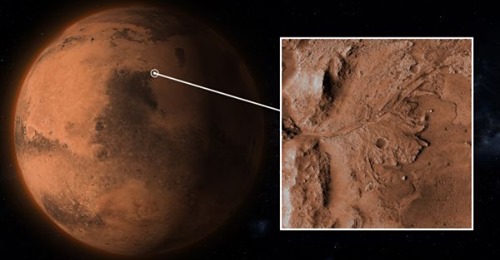
The Perseverance rover landing site on Mars.
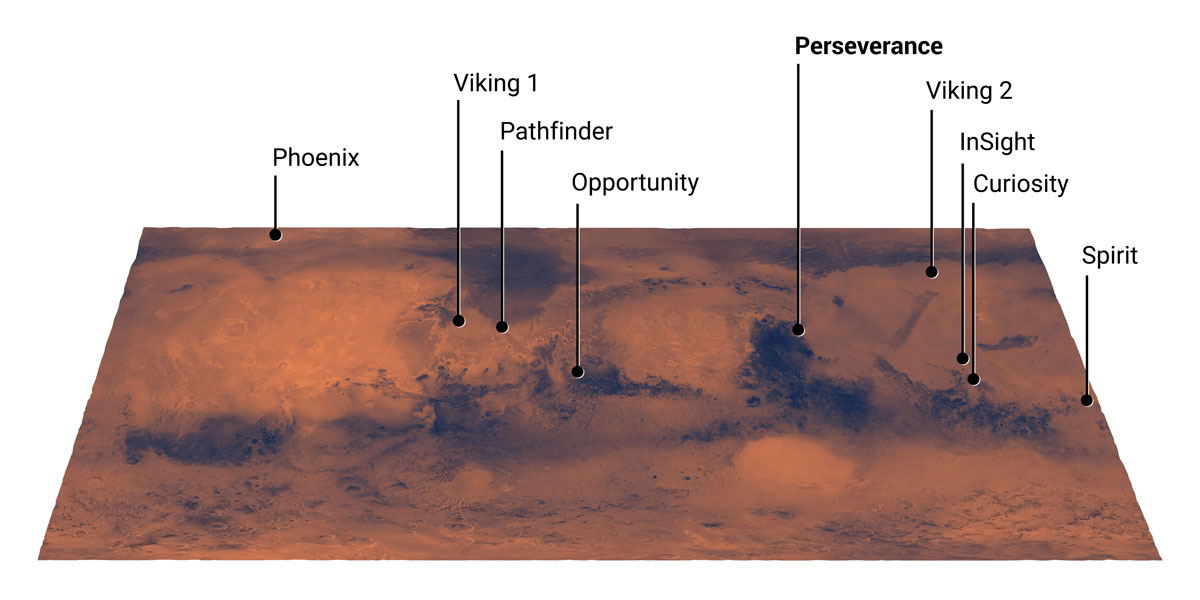
The Perseverance rover landing site as compared to other probe sites on Mars.
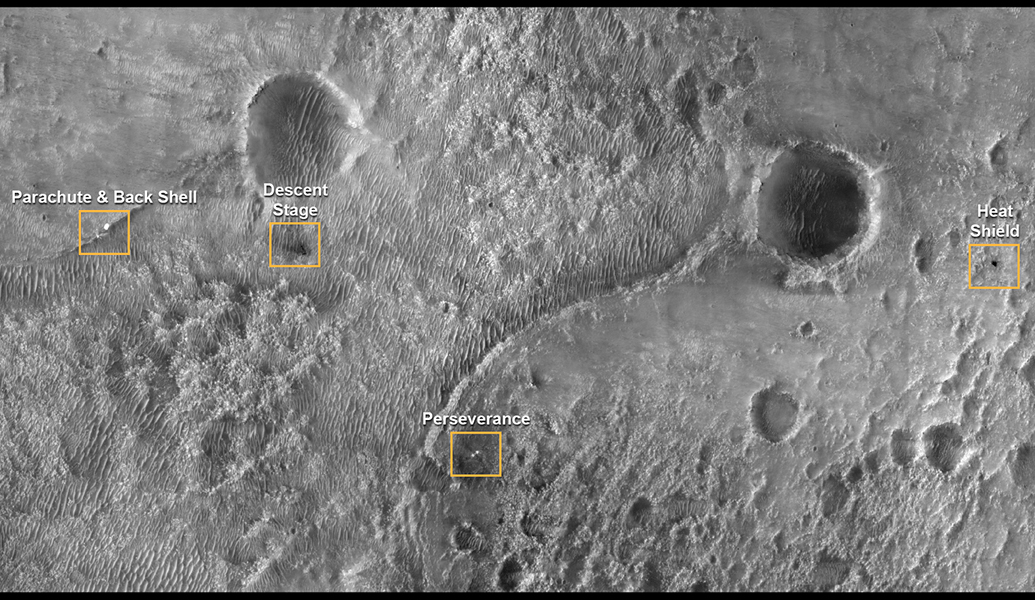
Seen from orbit a day after a dramatic arrival on the martian surface, the Perseverance landing site is identified in this high-resolution view from the Mars Reconnaissance Orbiter. The orbiter's camera image also reveals the location of the Mars 2020 mission descent stage, heat shield, and parachute and back shell that delivered Perseverance to the surface of Mars. Each annotated inset box spans 200 meters (650 feet) across the floor of Jezero Crater. Perseverance is located at the center of the pattern created by rocket exhaust as the descent stage hovered and lowered the rover to the surface. Following the sky crane maneuver, the descent stage itself flew away to crash at a safe distance from the rover, its final resting place indicated by a dark V-shaped debris pattern. Falling to the surface nearby after their separation in the landing sequence, heat shield, parachute and back shell locations are marked in the high-resolution image from Mars orbit.
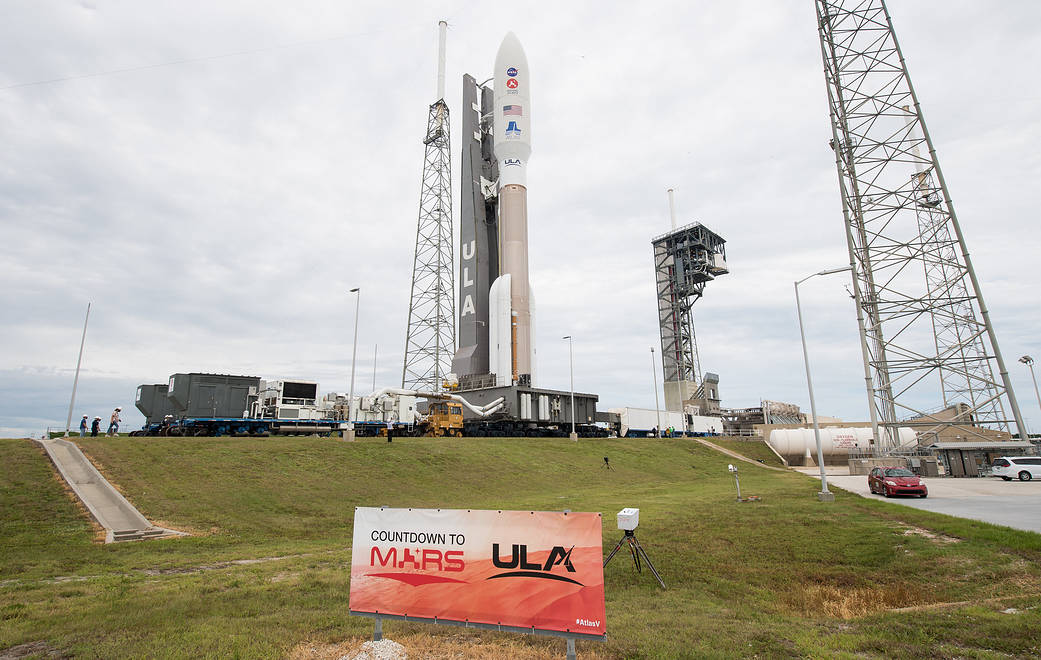
Mars 2020 atop its Atlas V-541 booster on the launch pad.
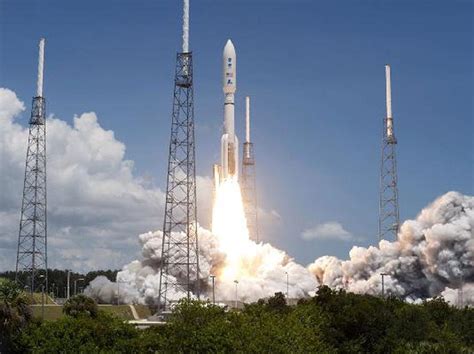
Launch date was July 20, 2020

Atlas V-541 booster sending Mars 2020 to orbit.
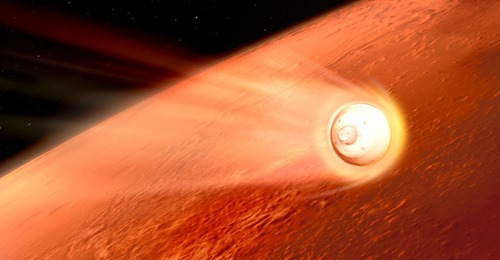
Mars 2020 entering the Martian atmosphere.
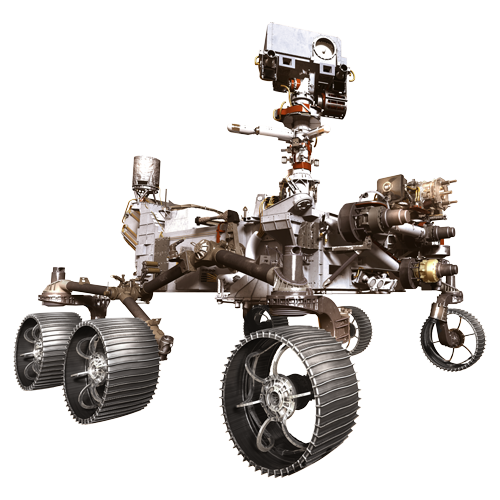
The rover landed Feb. 18, 2021

The rover has a new, more capable wheel design, among other improvements. For the first time, the rover carries a drill for coring samples from Martian rocks and soil.

From its landing site, “Octavia E. Butler Landing,” NASA’s Perseverance rover can see a remnant of a fan-shaped deposit of sediments known as a delta with its Mastcam-Z instrument. Scientists believe this delta is what remains of the confluence between an ancient river and a lake at Mars’ Jezero Crater. The delta remnant is the raised area of dark brown rock in the middle ground this image acquired Feb. 22, 2021.